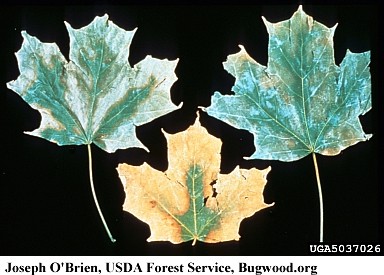 Description: Verticillium Wilt is a serious vascular disease of hundreds of woody and herbaceous plant hosts. One group not affected by verticillium wilt is the gymnosperms, such as pines and spruce. Verticillium wilt is also not a major problem in natural forested areas. Redbud and maple seem especially hard hit.
Symptoms: The most severe symptoms are wilting leaves and dieback of branches, often one at a time or on one side of the tree only. Other symptoms are: marginal browning and scorch of leaves in midsummer, small leaves, stunting, poor annual growth, and sparse foliage. Although some plants may die quickly, more commonly it takes one or more years.
A good field symptom that can set verticillium wilt apart diagnostically is the discoloration of xylem and cambial tissue, visible as streaks if you cut into the wood. If the branch or plant is cut and the cross section examined, the discoloration may appear as a ring. Other fungi can cause discoloration but it is a good field symptom and can be followed up for confirmation in a diagnostic lab.
Verticillium fungus can survive in the soil for many years. It infects the plant through wounds in the roots and in some cases direct penetration of the root. From root infections, the fungus spreads upward in the plant through the vascular system. The results of infection is tissue damage and plugged xylem, which robs stems and leaves of needed water and minerals. The fungus returns to the soil as plant parts die and fall to the ground.
Action: Plant disease resistant varieties. Keep plants as healthy as possible. Provide water during drought conditions. Apply a good fertilizer program. Prune out all dead branches because it helps overall plant health. It will not eliminate verticillium from the plant since the infections spread from the roots. Fungicides are not effective for control of this disease.
Thank you for reviewing this information. Schneider Tree Care is committed to preserving and enhancing the quality of your property through tree care education and services. We employ professionally trained and certified arborists who are available to meet with you for a consultation at no charge. If you have any questions or need additional information regarding the health of your trees, please contact us.
Description: Verticillium Wilt is a serious vascular disease of hundreds of woody and herbaceous plant hosts. One group not affected by verticillium wilt is the gymnosperms, such as pines and spruce. Verticillium wilt is also not a major problem in natural forested areas. Redbud and maple seem especially hard hit.
Symptoms: The most severe symptoms are wilting leaves and dieback of branches, often one at a time or on one side of the tree only. Other symptoms are: marginal browning and scorch of leaves in midsummer, small leaves, stunting, poor annual growth, and sparse foliage. Although some plants may die quickly, more commonly it takes one or more years.
A good field symptom that can set verticillium wilt apart diagnostically is the discoloration of xylem and cambial tissue, visible as streaks if you cut into the wood. If the branch or plant is cut and the cross section examined, the discoloration may appear as a ring. Other fungi can cause discoloration but it is a good field symptom and can be followed up for confirmation in a diagnostic lab.
Verticillium fungus can survive in the soil for many years. It infects the plant through wounds in the roots and in some cases direct penetration of the root. From root infections, the fungus spreads upward in the plant through the vascular system. The results of infection is tissue damage and plugged xylem, which robs stems and leaves of needed water and minerals. The fungus returns to the soil as plant parts die and fall to the ground.
Action: Plant disease resistant varieties. Keep plants as healthy as possible. Provide water during drought conditions. Apply a good fertilizer program. Prune out all dead branches because it helps overall plant health. It will not eliminate verticillium from the plant since the infections spread from the roots. Fungicides are not effective for control of this disease.
Thank you for reviewing this information. Schneider Tree Care is committed to preserving and enhancing the quality of your property through tree care education and services. We employ professionally trained and certified arborists who are available to meet with you for a consultation at no charge. If you have any questions or need additional information regarding the health of your trees, please contact us. 









